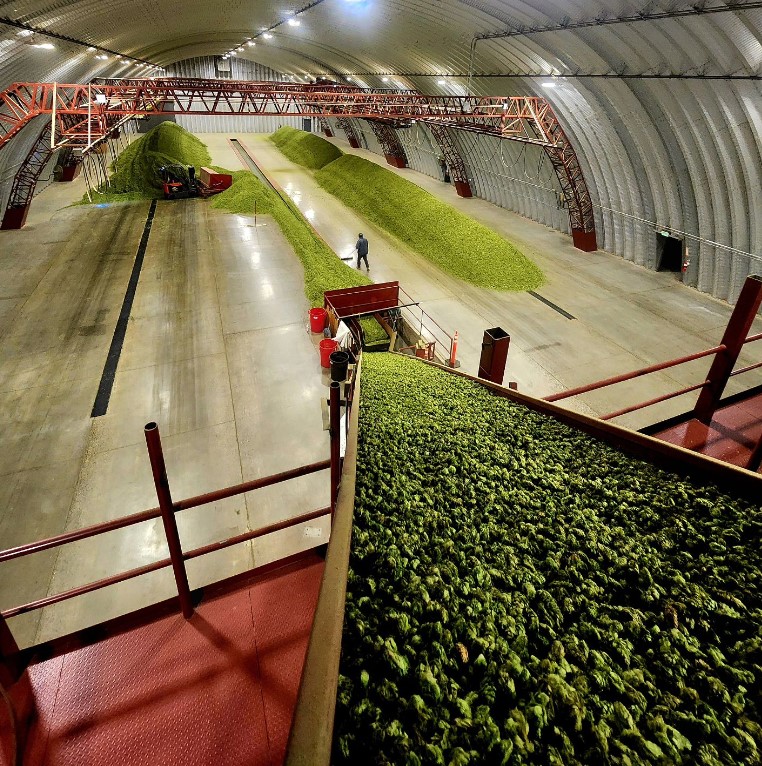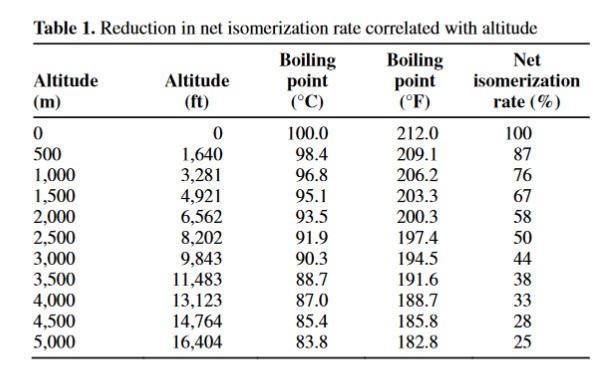* Temperature and thiol biotransformation
* Bitterness has an altitude problem
* CGX Fresh Hops
* Fresh hop festivals
* Hop profile: Peacharine
* Additional reading

Welcome to Vol. 8, No. 5. Harvest in the Northern Hemisphere is at full throttle. My Instagram feed if stuffed with photos from every angle of harvest. This one from @carpenterhops in the Yakima Valley is particularly striking.
FREEING THIOLS, BUT TO WHAT END?
Researchers from Oregon State University and Lallemand Brewing presented information at the 2024 EBC Congress and Brewers Forum in France that showed a strong correlation between increasing fermentation temperature and free thiol formation. The results also remind brewers that free thiols alone do not necessarily produce the most fruity, citrus, and tropical-flavored beers.
The research examined the performance of five commercial yeast strains at three temperatures (15°C, 22°C, 30°C/59°F, 71.6°F, 86°F). Pale ales were hopped with 1.2g/L of Cascade at the start of kettle boil and 3.0 g/L of Cascade in the whirlpool. They were not dry hopped.
They measured the levels of 3-sulfanylhexan-1-ol (3SH) and 4-methyl-4-sulfanylpentan-2-one (4SMP). Those increased with temperature across all yeast strains. LalBrew Diamond lager yeast produced the highest overall concentrations of both thiols. LalBrew Nottingham and London ale strains showed the greatest changes with temperature. LalBrew Verdant IPA and BRY-97 showed less change in thiol concentrations with temperature.
Although the Diamond lager strain produced more than two times higher levels of 3SH and 4SMP than the other strains, the beer fermented with it had the lowest perceived fruity-tropical character. The report suggests this was probably because of lower amounts of other aromatic fermentation compounds in addition to an accompanying noticeable sulfur/egg character.
As well as elevating thiol levels at 20-30°C, the Nottingham, Verdant IPA and London strains produced higher levels of 2-phenylethyl acetate, isoamyl acetate, 2-phenylethanol, compounds, β-ionone, β-damascenone and α-terpineol, while correlating with higher perceived citrus and tropical aroma than the other beers.
BITTERNESS AND ALTITUDE

© 2017 Master Brewers Association of the Americas. Reproduced, by permission, from Palmer, J. 2017. A look at isomerization reduction due to altitude. Tech. Q. 54(3):120-22. doi.org/10.1094/TQ-54-3-0806-01
I posted this chart six years ago. Here it is again, because a) only hundreds of you had subscribed by early 2018, b) although the information is archived, who visits the archives?, and c) I’ve had two recent conversations with homebrewers who were not aware how much altitude may impact bitterness because wort boils at a lower temperature at higher altitudes.
When we moved from the low-altitude flatlands of Illinois 700 feet) to New Mexico (5,320 feet), a professional brewer told me to just throw in a few more pellets when I brewed an IPA. I hope the information in the archives is more useful.
CGX FRESH HOPS
Crosby Hops has a new advanced product and a limited amount to trial from this harvest. To create CGX Fresh Hops, they use a patent-pending cryogenic process that involves flash-freezing hops at harvest, ensuring the hops will remain fresh for up to 30 days. They come in a powder-like consistency, similar to kinetic sand. Details and instructions on how best to use them are available here. They have a limited amount of Cascade this season, and are taking orders for 2025.
If “frozen cryo hops” sounds familiar it maybe because you remember Yakima Chief Hops Trial 301, introduced in 2022 but since discontinued.
FRESH HOP FESTIVALS
Sept. 20-Oct. 6: Fresh Hop Pop-Up Beer Fest
Portland Beer Week presents a pop-up Fresh Hop beer garden running daily from 8 a.m.-10 p.m.
Sept. 22: New York Wet Hop Festival
This is the second year for the Hop Growers of New York wet hop festival, and it has expanded to three locations on three different dates. It begins at Torch & Crown in Manhattan.
Sept. 27-28: Rose City Fresh Hop Festival
Find a list of breweries here.
Sept. 28: Joyride Fresh Hop Fest
13 Colorado breweries. No cost for admission, no tokens or tickets, just stop by Joyride Brewing in Denver and order a pint (or more).
Sept. 28: New York Wet Hop Festival
The second stop for the Hop Growers of New York festival, at Rusty Nickel Brewing in West Seneca.
Oct. 5: Fresh Hop Ohio
Ohio have hold two festivals this year, one at High Grain Brewing in Cincinnati, and the other at Unhitched Brewing in Louisville (Ohio, of course).
Oct. 5: The Original Fresh Hop Festival
The festival began in Yakima, Washington, in 2003 with fewer than 10 breweries. Now more than 70 breweries, wineries and cideries will serve more than 7,000 attendees.
Oct. 5: Hood River Hops Fest
A new location for the Oregon festival.
Oct. 5: New York Wet Hop Festival
The third stop for the Hop Growers of New York festival is Indian Ladder Farms in upstate New York.
HOP PROFILE: PEACHARINE
Origin: Peacharine is the first named release from the New Zealand’s Hapi Research breeding program, which is a joint venture between Freestyle Hops and the Garage Project brewery. Her name is quite clever, but, of course, she has to live up to it. Another reason to highlight her is information Freestyle will provide if you ask.
When a variety gets a name, say Luminosa from Indie Hops in Oregon, a press release will provide a little bit of information about what I label The Basics. Freestyle includes more than others.
David Dunbar, managing director at Freestyle explained via email the how and why of what they are providing. “We are mainly using the University of Auckland for our testing now. They pioneered LC-MS/MS and GC-MS/MS methods of highly precise thiol and terpene alcohol testing in wine and now are doing the same testing for hops. Our numbers will be comparable to testing at other top tier labs with PPB (parts per billion) accuracy. . . . These numbers wouldn’t be comparable to other sources who use GC-SCD or GC-MS methods and mostly report simple percentages rather than actual concentrations.”
The basics: 7.4% alpha acids, 6.5 beta acids, 2 mL/100 grams total oil. A few of the measured compounds [average for 2024 crop sampled, parts per billion]:
linalool 16,107
geraniol 17,187
alpha terpineol 381
3SH 12.1
3S4MP 13.4
4MSP 1.7
Aroma qualities: Rich peach/nectarine up front. Sweet fruit, lime zest and floral notes in the background.
Also notable: Freestyle provides data about the levels of polyfunctional thiol precursors as well as for free thiols. That leads to a discussion that deserves a larger section of Hop Queries, so I am putting it on my to do list. For now, I will point out that Hapi has another cultivar, Manilita, which is not guaranteed a wide release but has an interesting profile. She has a level of 3S4MP comparable to Mosaic. That’s something for a brewer to know when thinking about how to put her to work in a beer.
Is it necessary to know she contains 31.7 ppb 3S4MP? Useful, yes; totally necessary, no. I am a believer that more information is always welcome, but recognize at some point a busy brewer might consider it too much noise. That is why I also recommend the thiol impact list that Hopsteiner assembled.
ADDITIONAL READING
* Haas brings new farm online. Were I going to be in the Northwest for harvest this year, the new John I. Haas facility in the Wenas Valley north of Yakima would be an essential stop. It is fascinating to see the choices made when there is an opportunity to start from scratch, as they say, and incorporate the latest technology.
* The New Nobles: Michigan Hops. Sigh. I hate to be the curmudgeon here, because Michigan farmers grow some excellent hops, particularly Chinook. So, a) not to belabor the point, but noble is a lousy way to describe a cultivar, and b) the story implies that the Michigan hop industry is growing, while at the same time reporting acreage has shrunk by almost two-thirds since the teens. It will take more support from Michigan breweries if growth is going to return.
ABOUT HOP QUERIES
Hop Queries is a free monthly newsletter from Stan Hieronymus, sponsored by Best of Craft Beer Awards. Please forward the newsletter to peers you think would enjoy it, and suggest they subscribe.